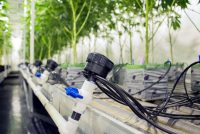Cannabis cultivators across the U.S. are confronting plummeting wholesale prices and tighter profit margins. Operators in Pennsylvania say flower prices have fallen from around $4,000 a pound to around $3,000, on average, and prices in the more mature markets of California, Oregon and Colorado have experienced extreme volatility. Prices in those states are averaging around $700 per pound but of course, that’s an average. There are whispers that prices are as low as $150, revealing how bad the situation really is.
Oversaturation of legal cannabis affects commercial growers everywhere. For example, when Oklahoma opened its free-wheeling medical cannabis program with unlimited business licenses, the pipeline of cannabis from legacy markets in California was disrupted and a glut of flower from the gray market began to influence pricing within the state’s legal market. Although cannabis is not federally legal and interstate commerce is banned, what happens in one state definitely affects what happens in another.
Competition in legal markets has also increased dramatically in recent years as multistate operators expand their footprint and consolidation proliferates. Vertically integrated cultivation, manufacturing and retail is becoming unsustainable for many mom-and-pop businesses, while MSOs can leverage their cash and resources to weather the current storm.
Economic Viability Meets High Quality Production
All of this news is not necessarily negative, but it’s a definite cautionary tale: Being complacent opens opportunities for others. Growing cannabis is complex. It is working with a living and breathing machine. Some businesses fail because operators are not able to find the perfect blend of horticulture, plant science and manufacturing efficiency necessary for success. Some see it simply as a manufacturing concern, others a scientific endeavor, and still others as an artform. An understanding of growing cannabis as a blend of all three is paramount.
 Just like the LED evolution, other new cultivation technology is here to stay and should not be brushed off as just experimental
Just like the LED evolution, other new cultivation technology is here to stay and should not be brushed off as just experimentalSqueezing more high-quality product out of existing facilities is essential. Costs for labor and electricity are relatively fixed, so operators must turn to technology to improve yield, quality, consistency and plant health without increasing operating expenses.
Over the years, growers have often resisted change surrounding what they view as “the way” or “the best,” but with the industry in such distress, the time is now to address facility inefficiencies.
Much like the evolution of LED use, there might be an initial skepticism at the cost and real value of new cultivation technology, but the economics are too compelling to ignore. The majority of all indoor grows now use LED. The progression from single-ended bulbs, to double-ended HPS, to LED is analogous to plants on the floor of a grow facility, to rolltop benches, and now to vertical farming using racks.
Vertical Cultivation Science
Crop steering applies plant science directly to commercial production. The methodology is based on the idea that plants can be manipulated to grow and perform a certain way. For cannabis plants, the science really comes into play with inter-canopy airflow.
When airflow occurs under the surface of the leaf of the plant, the stomata opens and gas exchange increases as water vapor and oxygen are released and carbon dioxide is absorbed. The micro-barrier of air trapped against the leaves is broken and the exchange of gasses and energy in the cultivation environment is improved, enabling the entire grow to increase its yield. And while CO2 supplementation is widely used and has been for years with positive effect, the under-canopy airflow provides greater efficiency relative to the operating expense of pumping CO2 into the grow room. Money can be saved by applying science to encourage the plant to uptake the extra CO2 that has been naturally released.
Proper Drainage Is Also Key
 Controlling the space with proper drainage will keep a host of problems at bay
Controlling the space with proper drainage will keep a host of problems at bayDrainage issues like the puddling of water in vertical farming are detrimental to the efficiency of a cultivation facility. Even when growers use precision irrigation techniques to give the plants pinpointed irrigation volumes over different time periods, rack systems can still suffer from drainage issues. That means that affected plants are not receiving the precision irrigation strategy and the entire purpose of the scientific application is defeated.
Precise drainage is critical because standing water opens the door to root born disease, pests, and microbial issues. Spray regimes can address this problem, but they cost money. The key is to reduce dependency on mitigation efforts by better controlling the agricultural space and improving outcomes with a scientifically approached plan.
Greenhouses, warehouses and vertical farming facilities all have potential environmental issues that reduce their economic viability, but with proper vertical air movement, drainage equipment and an understanding of microclimates and how to address them scientifically, efficiency and product quality are enhanced.
Time to Embrace Change
As with any industry, there is resistance to adopting new technology in cannabis cultivation. The original and legacy players will always claim they know how to best grow their plants, but the reality is that the business needs must be addressed.
As canopies increase within a facility, advancements like robotics, LEDs and advanced airflow technology define how the industry operates and continues to improve. Efficiency keeps business alive—cannabis growers must continually assess their operations and make the capital investments that will pay off as wholesale prices continue to decline.
Copyright
© Cannabis Industry Journal

